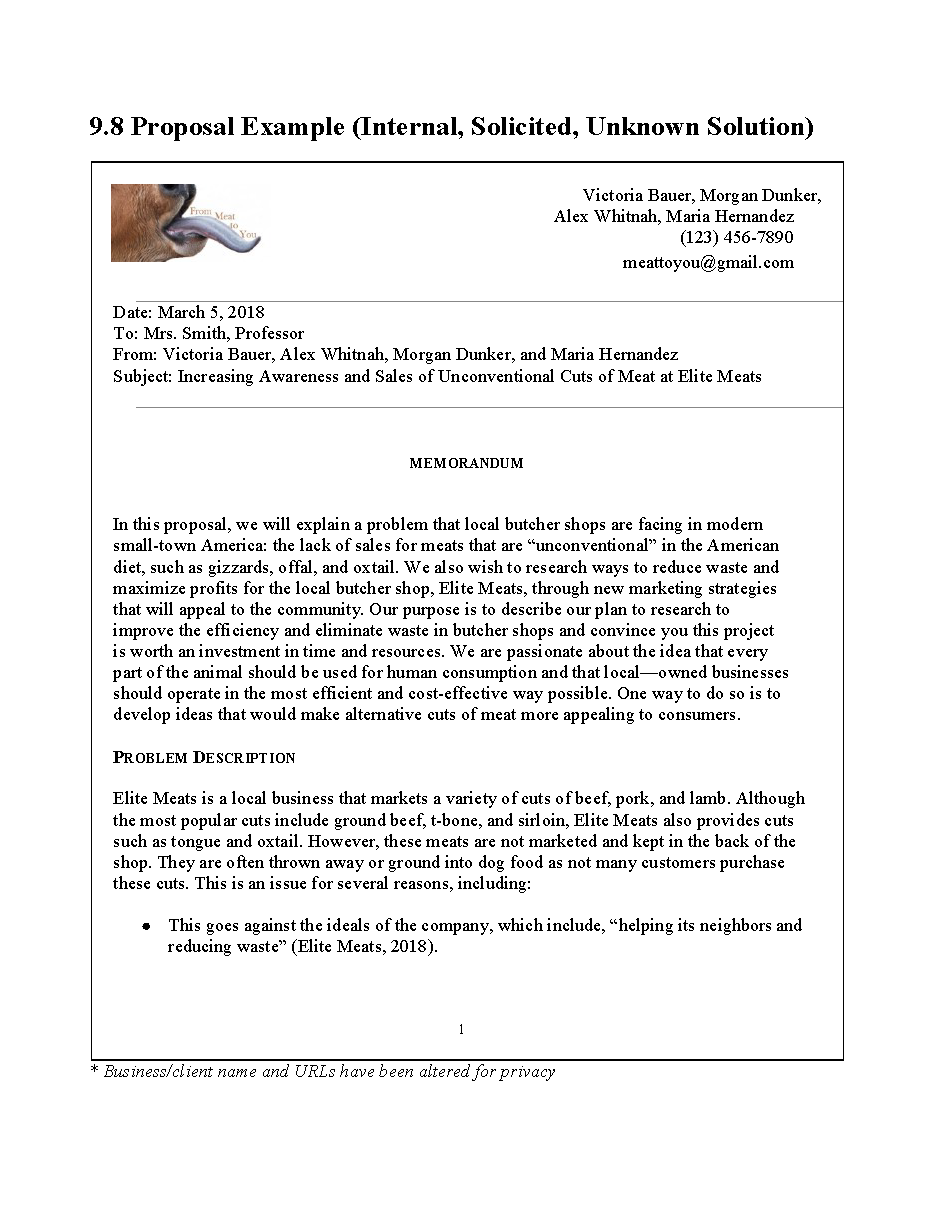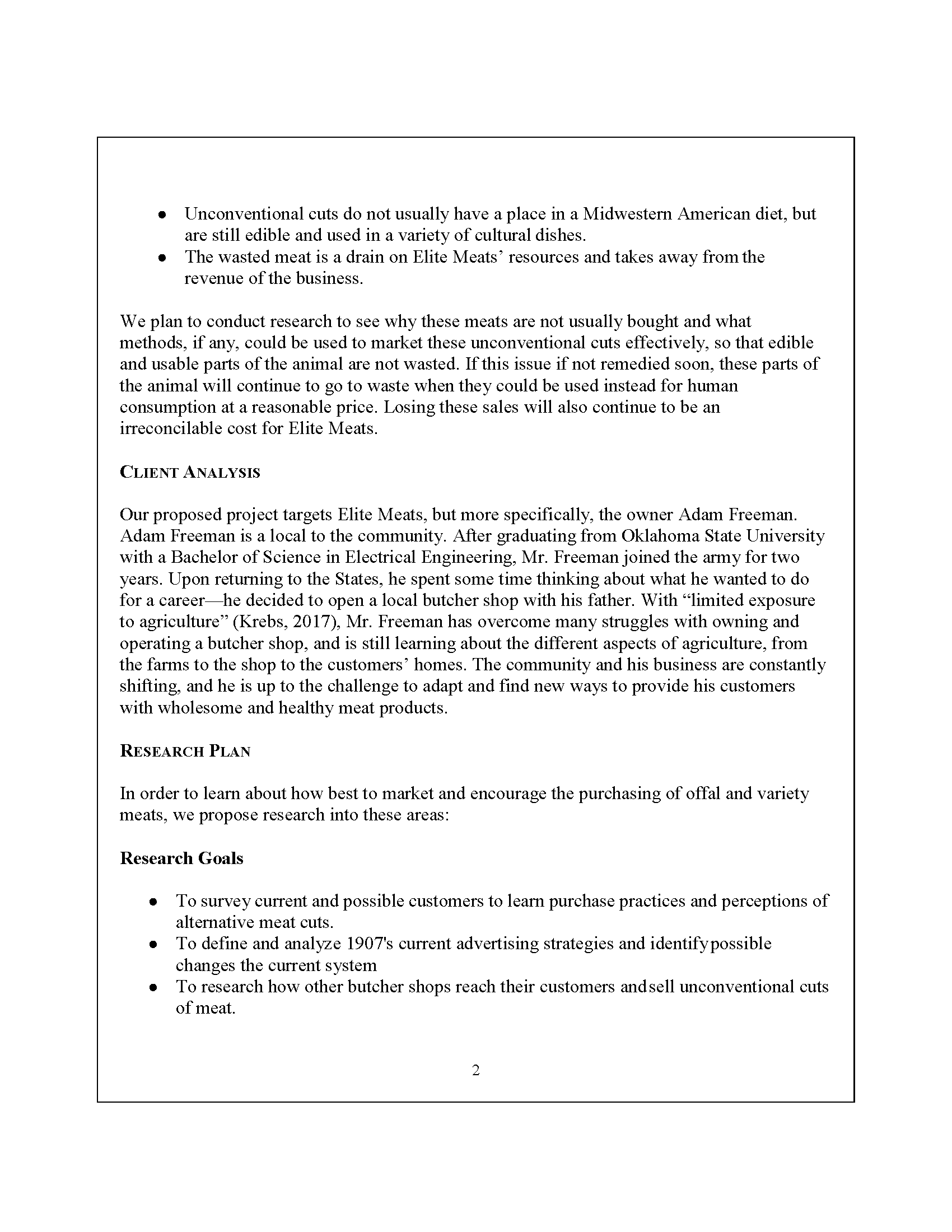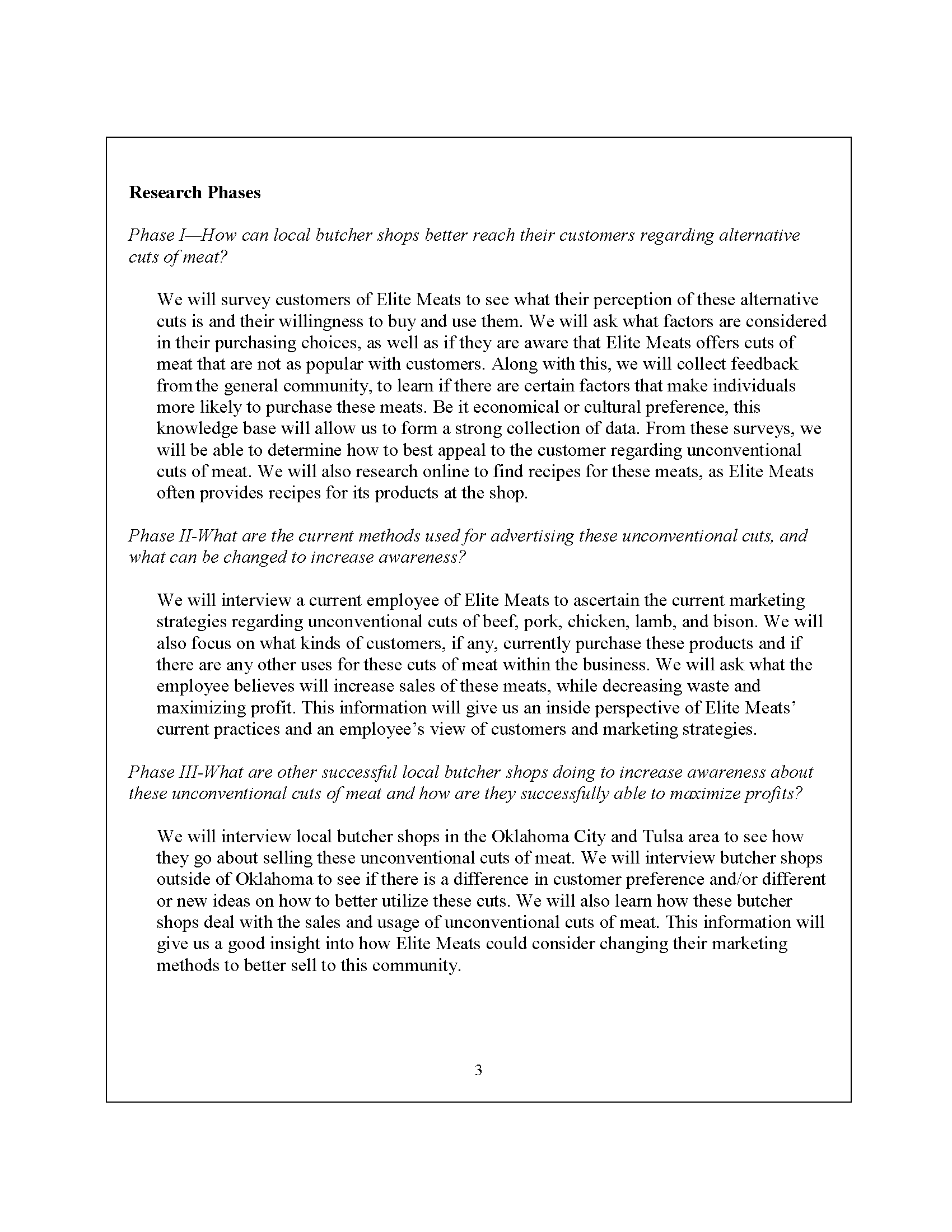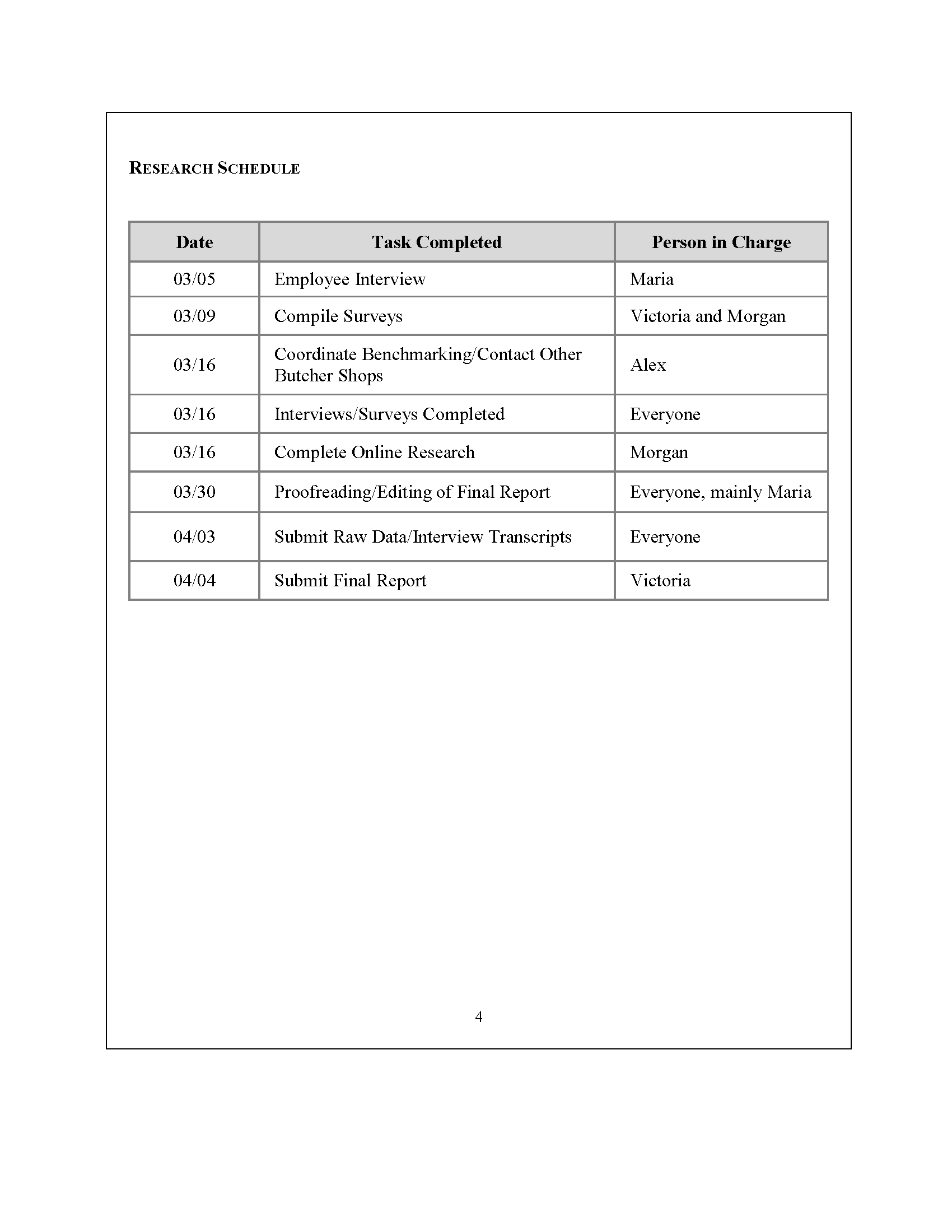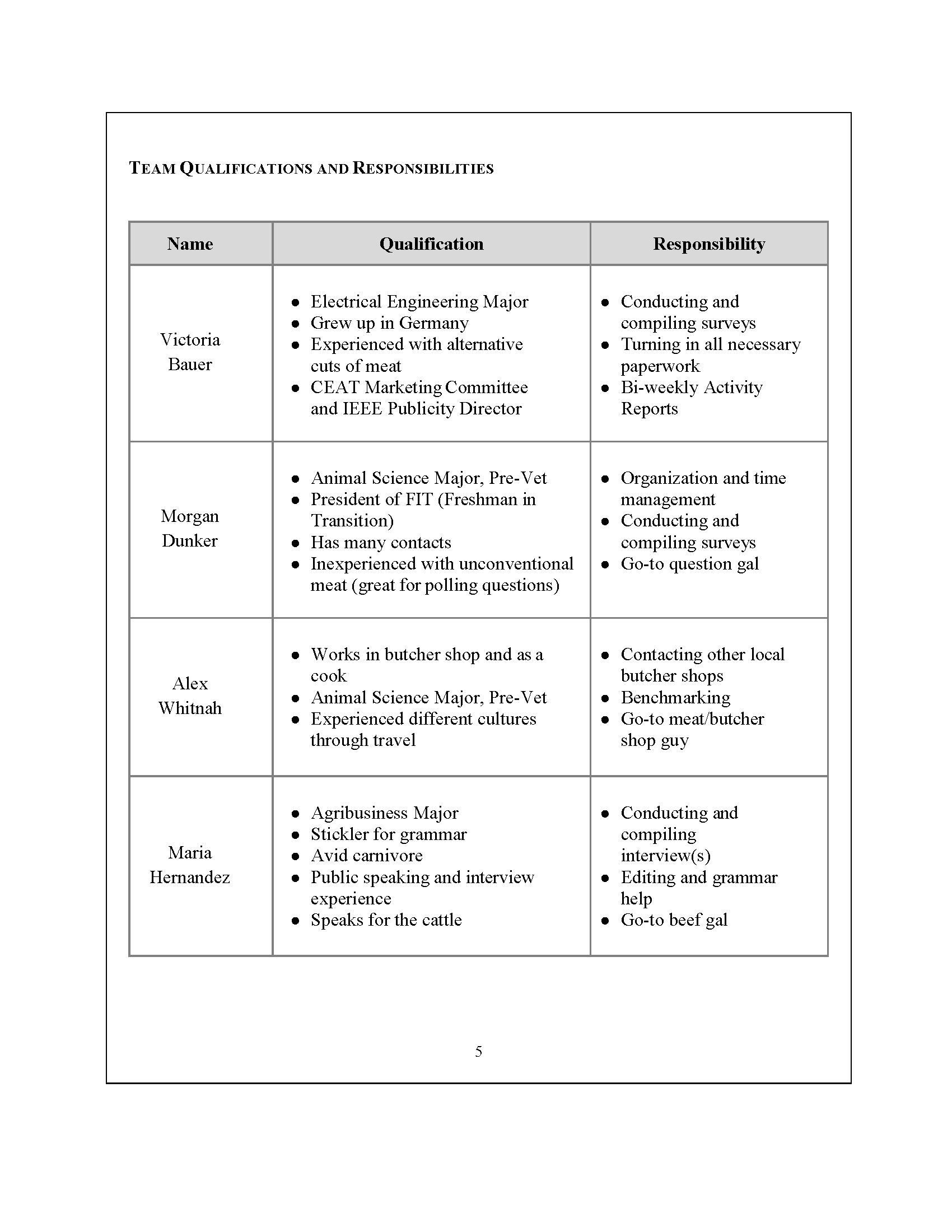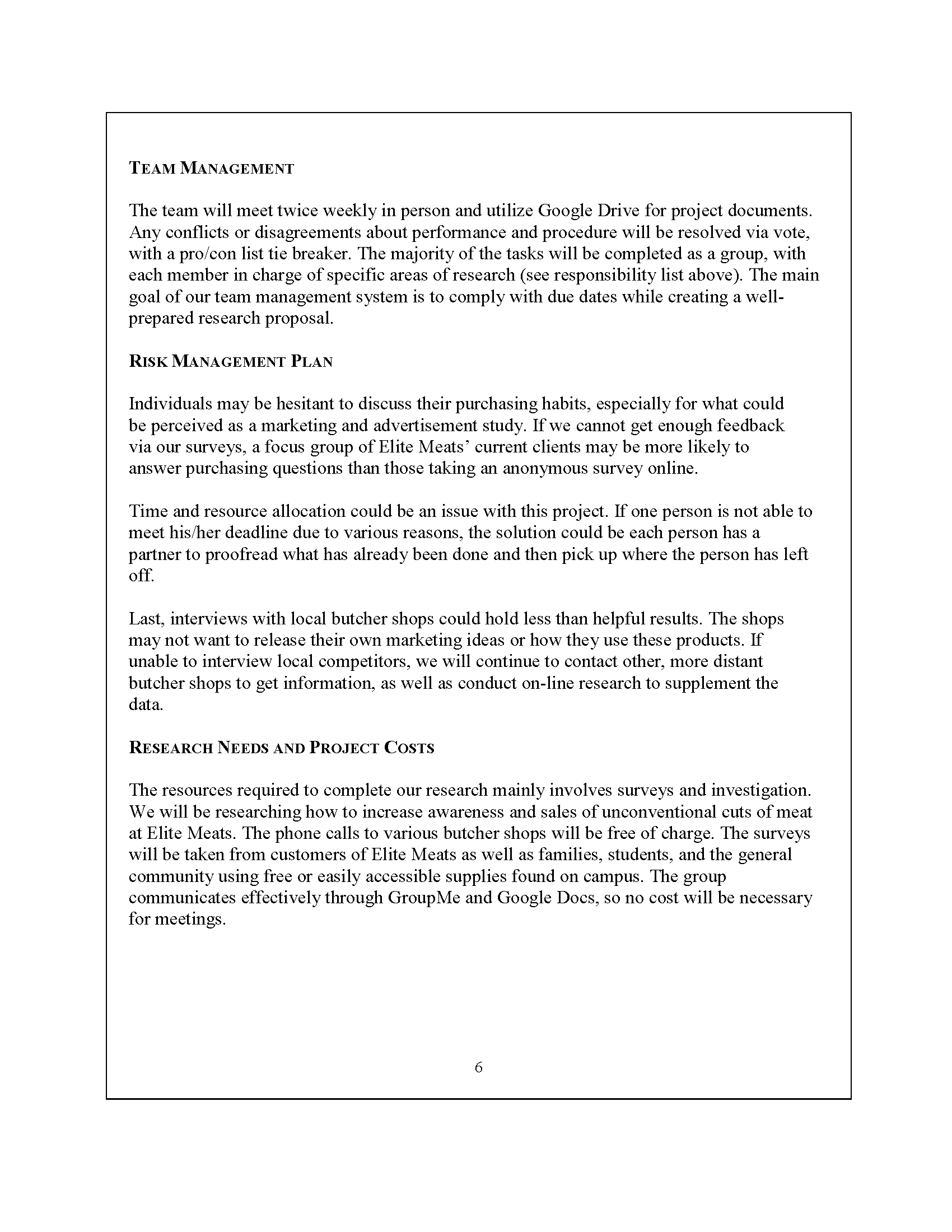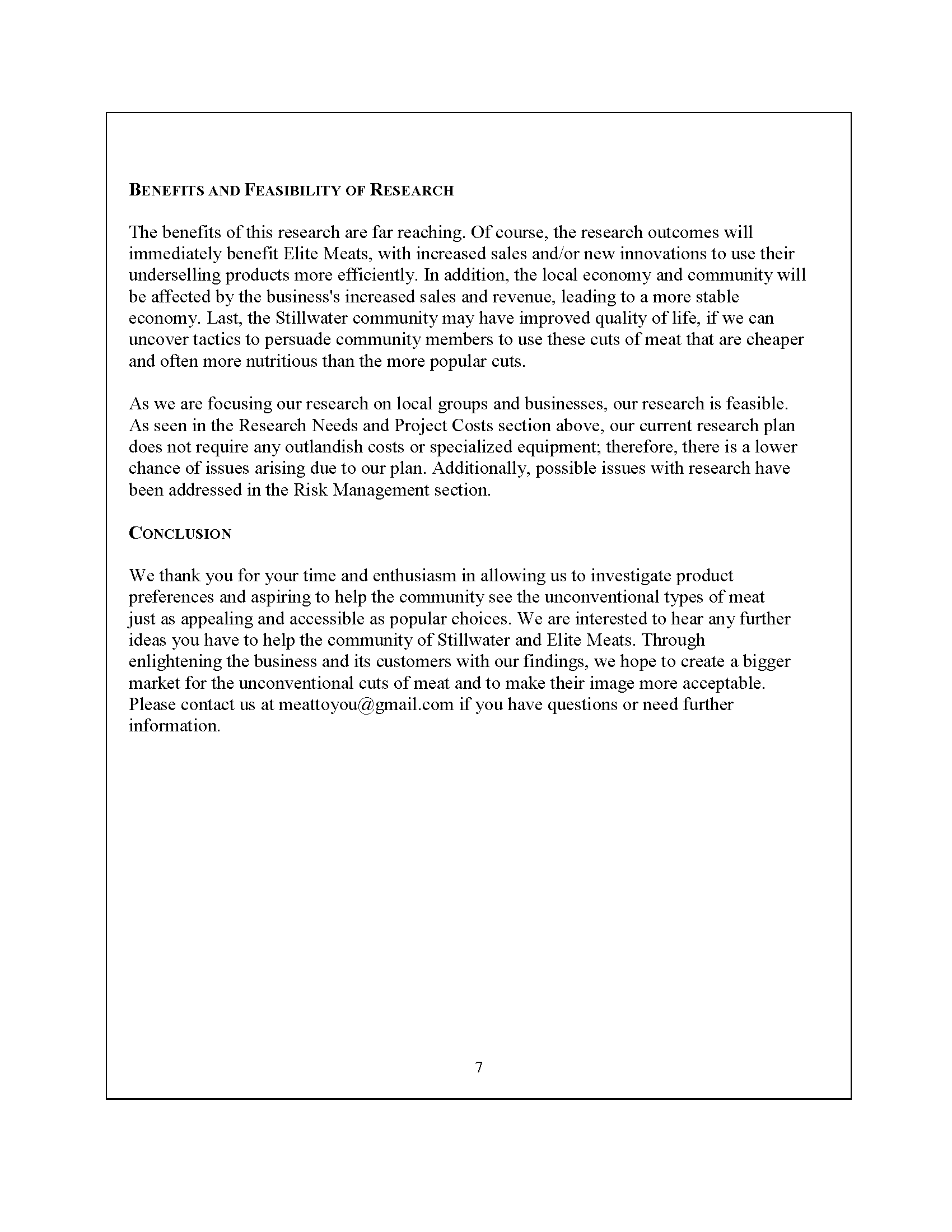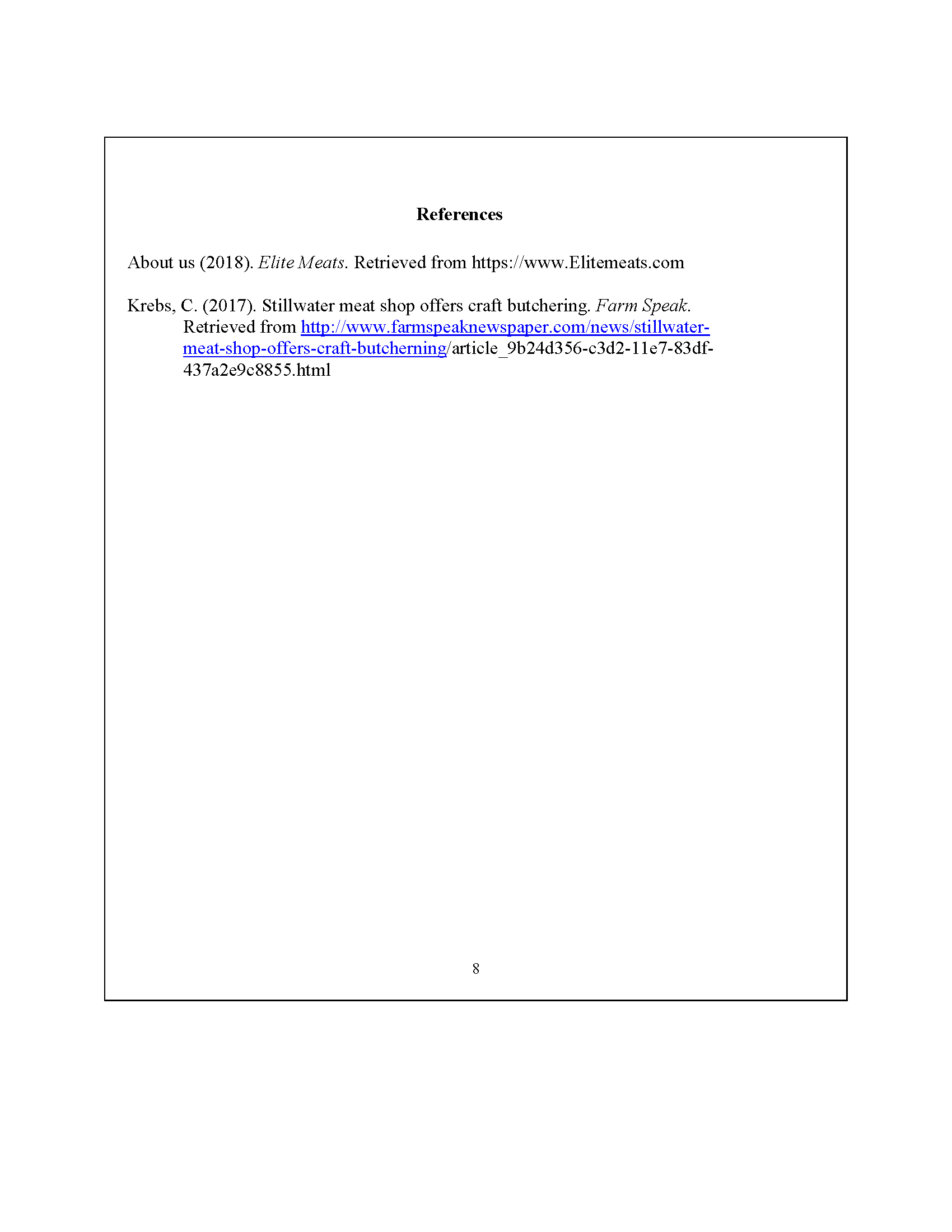Chapter 9: Proposals
Staci Bettes
Chapter Synopsis
This chapter defines when, where, and how you should use a proposal. Before drafting, you define some preliminary qualities, including if the proposal is written for internal or external audiences, is solicited or unsolicited, and if you are proposing a known or unknown solution. Next, the chapter discusses further considerations for your audience, followed by a breakdown of common sections present in most proposals. As proposal content can vary depending on the type and purpose and audience, a section is included with additional, project-specific sections which could be included in your proposal, such as client analysis and implementation. The standard design and format of a proposal is discussed, with emphasis on adaptability for the reader. The end of this chapter contains a revision checklist for proposals.
9.1 Introduction
This chapter focuses on the proposal—a type of document that gets you or your organization approved or hired to complete a project, or requests time and resources to study difficult problems. The proposal is your opportunity to pitch your idea for change (oftentimes an improvement) within an organization, or to draft a research plan to investigate an issue that is of concern to your institution. Proposals often demonstrate that a problem or opportunity exists that needs attention, and addresses a very specific audience, one with the authority to move your suggestions forward.
A proposal is an offer or bid to complete a project for someone. They may contain other elements—technical background, recommendations, results of surveys, information about feasibility, and so on. But what makes a proposal “a proposal” is it asks the audience to approve, fund, or grant permission to do the proposed project. It should contain information that would enable the reader to decide whether to approve a project, to approve or hire you to do the work, or both. To write a successful proposal, put yourself in the place of your audience—the recipient of the proposal—and think about what sorts of information that person(s) would need in order to feel confident having you complete the project.
It is easy to confuse proposals with other kinds of documents in technical writing. Imagine that you have a terrific idea for installing some new technology where you work, and you write up a document explaining how it works, showing the benefits and then urging management to install it. All by itself, this would not be a complete proposal. This is a feasibility report, which studies the merits of a project and then recommends for or against it. However, all it would take to make this document a proposal would be to add elements that ask management for approval for you to go ahead with the project. A main difference between a proposal and other documents is that a proposal will sell the writer (or the writer’s organization) as the one to complete a future project.
In a technical writing course, the proposal assignment is an opportunity for you to present an idea you have to improve a certain aspect of a company, organization, center, or other business. It is written to a specific, known reader, who has the power to approve or deny your project. A good proposal often leads to conducting research and creating a report; therefore, whatever topic you choose, you must be able to conduct research on it, which will be integrated into that final report. In addition to primary research such as interviews and surveys, if your technical writing course requires that you integrate scholarly research into your final report, choose a topic for which you can readily find such material.
Not all research topics are appropriate for technical writing. Topics that are based on values and beliefs do not fall into the category of technical. Historical and literary topics do not qualify. For example, a proposal on the topic “Gone with the Wind is the best book ever written” would not be appropriate, as you cannot prove and verify an opinion—everyone has their own taste. However, you could write a proposal to research the feasibility of declaring Gone with the Wind the “official novel” of Atlanta, Georgia.
9.2 Types of Proposals
Consider the situations in which proposals occur. A company may send out a public announcement requesting proposals for a specific project. This public announcement—called a request for proposals (RFP)—could be issued through websites, emails, social media, newspapers, or trade journals. Firms or individuals interested in the project would then write proposals in which they summarize their qualifications, project schedules and costs, and discuss their approach to the project. The recipient of all these proposals would then evaluate them, select the best candidate based on the plan which best suits the company’s needs, and then work up a contract.
But proposals can also be less formal. Imagine that you are interested in doing a project at work (for example, investigating the merits of bringing in new technology to increase productivity). You met with your supervisor and tried to convince her of this. She might respond by saying, “Write me a proposal and I’ll present it to upper management.” This is more like the kind of proposal you will write in a technical writing course.
There are several aspects of the proposal that you need to determine before drafting. Identifying these factors are vital to creating a proposal which will be accepted—whether the proposal is written for internal or external readers, the proposal is solicited or unsolicited, and if the solution is known or unknown.
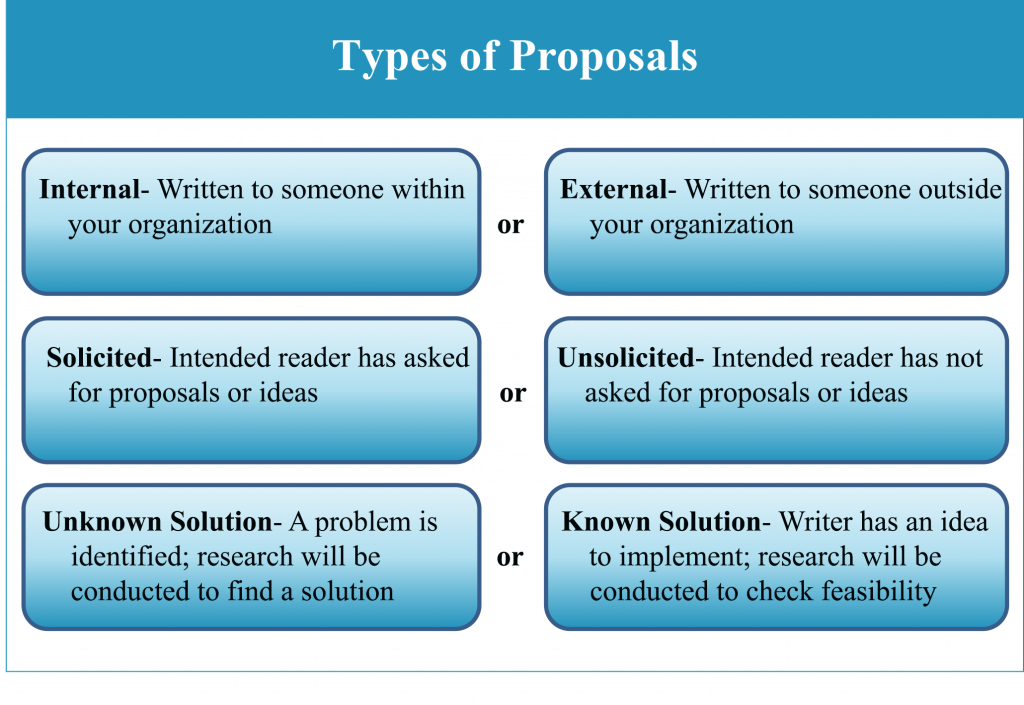
Internal or External
- Internal: A proposal written to someone within your organization (a business, a government agency, etc.). With internal proposals, you may not have to include certain sections (such as qualifications) or as much information in them. For example, if your manager asks for ideas to improve the average time it takes to return customer inquiries, you would create an internal proposal.
- External: A proposal written from one separate, independent organization or individual to another such entity. With an external proposal, you will need to not only persuade the reader that you have a solid plan, but establish your credibility with the reader. The typical example is an independent consultant proposing to do a project for another firm.
Solicited or Unsolicited
- Solicited: The recipient has requested the proposal. If you have been asked to submit a proposal, it is considered solicited. The solicitation may come in the form of a direct verbal or written request, but normally solicitations are indirect, open-bid to the public, and formally published for everyone to see. A request for proposal (RFP), request for quotation (RFQ), and invitation for bid (IFB) are common ways to solicit business proposals for business, industry, and the government.
Proposals can also be solicited on a local level. For example, you could be explaining to your boss about a new software you think should be installed in the office; your boss might get interested and ask you to write up a proposal that offered to do a formal study of the idea.
- Unsolicited: The recipient has not requested your proposal. With unsolicited proposals, you sometimes must convince the recipient that a problem or need exists before you can begin the main part of the proposal. Unsolicited proposals are the “cold calls” of business writing. They require a thorough understanding of the market, product and/or service, and their presentation is typically general rather than customer-specific. They can, however, be tailored to specific businesses with time and effort, and the demonstrated knowledge of specific needs or requirement can transform an otherwise generic, brochure-like proposal into an effective sales message.
Getting your tailored message to your target audience is often a significant challenge if it is unsolicited. Unsolicited proposals are often regarded as marketing materials, intended more to stimulate interest for a follow-up contact than make direct sales. A targeted proposal is your most effective approach, but you should recognize the importance of gaining company, service, or brand awareness as well as its limitations.
Known Solution or Unknown Solution
- Unknown Solution: You can identify a problem, but are unsure what the solution is without further inquiry. Your proposal will focus on describing the problem, showing need for improvement, and planning research to discover the most effective solution. With an unknown solution, you may have a hypothesis—an idea that you think will solve the problem. However, this “educated guess” needs to be proven or disproven through research. The findings and recommendations will be included in a future report (e.g. recommendation report). For example, you notice that the office computers are lagging and crashing often, but are unsure why. You would propose research on making the computers more efficient.
- Known Solution: Instead of focusing on a problem that needs research, your proposal focuses on feasibility—i.e. can a specific solution resolve the problem, and what is the best way to implement the specific action, item, or idea? You propose research on areas such as cost, effectivity, location, and other factors connected to your solution. An example of a known solution is proposing your department replace a dozen 2016 Dell computers with the newest MacBook Pro model in an effort to improve computer speed, decrease user frustration, and increase employee productivity.
9.3 Proposal Purpose and Audience
Remember that, in a technical writing course, the proposal assignment serves several purposes:
- It gives you some experience in writing formal requests.
- It gets you started planning your major assignment.
- It gives your instructor a chance to work with you on your project, to make sure you have a viable topic.
For the second and third reasons, you need to include specific elements in your proposal (as noted in your assignment sheet), some of which may not seem appropriate in a real-world proposal.
The proposal is often the beginning of a weeks-long research and writing process that goes through many stages until it gets to the end point: the recommendation report. In this case, you only submit the proposal once during this process; in a real-world setting, you may have to submit a proposal multiple times—making corrections, adding details to your research plan—before you receive approval to move forward with the project. And even after submitting the proposal and receiving permission, you may need to write and submit additional documents along the way such as: a progress report, an outline, an annotated bibliography, a graphics draft, a recommendation report draft, and a final recommendation report. Be careful to use the term proposal only if you are specifically referring to the proposal stage of your project.
Another point to keep in mind relates to the audience for different kinds of documents that may be produced for the same project. Consider the example of a proposal written to a supervisor at a solar power company suggesting the creation of a policy manual for residential installers. The proposal’s audience may be an executive, whose knowledge of the technicalities is very broad. Let us imagine the executive approves the proposal and requests completion of the manual, which will be produced well after the proposal. The manual’s audience is the technicians, who may have more specialized knowledge than the executive. The content and language used for these two different audiences will need to be adjusted to fit the writing situation. (See chapter 2)
To write for the specific document’s audience, it is a good idea to define your reader and sketch out some qualities about them before you begin drafting. This information will help you effectively persuade the reader to approve your proposed project, and help you stay on task writing for that reader. It can also help you shape your proposed research strategy and guide the type of information you include in your proposal.
Ask yourself:
- Who is your reader? Your reader should be someone with decision-making authority over your problem. Theoretically, they could implement any changes you ultimately suggest. They are an action-taker in a corporation, organization, business, or agency.
- What type of reader are they? Expert, technician, executive, gatekeeper, and/or non-specialist?
- What is their background and knowledge level on the topic? What are their needs and interests? What will likely persuade them to approve your proposed idea? Wants? Values? For example, if you want to request time and resources to investigate whether changing your company’s workweek schedule from a standard five days to four extended work days, you would want to frame the idea in terms that management would be interested in—increases in productivity, savings in building upkeep and utilities, and so on.
9.4 Common Proposal Sections
The following provides a review of the sections you will commonly find in proposals. Do not assume that these sections must be in every proposal you write, nor that they have to be in the order they are listed. Refer to the assignment sheet provided by your instructor (or if on the job, review all content and submission requirements) and consider other kinds of information unique to your topic that should be included in your particular proposal.
Most proposals include the following sections: Introduction; Description of the problem, opportunity, or situation; Background of the problem; Method and procedure; a Schedule; Cost and required resources; Benefits and feasibility; Conclusion; and References.

Introduction
Plan the introduction to your proposal carefully. Make sure it contains all the following rhetorical moves (but not necessarily in this order) that apply to your particular proposal:
A) Define the subject. Make it clear to the reader what the topic will be.
B) State the purpose of the document. The purpose of proposals is typically to request time and resources to study a problem, develop a new product, or investigate previously proposed solutions, etc.
C) State the main point of the document. The main point is often to convince your reader (usually a supervisor or client) that the proposed project is deserving of approval. Be clear and concise about why you wrote the proposal and what action you want the reader to take.
D) Stress the importance of studying this problem or implementing your solution. The importance may relate to the topic’s urgency.
E) Develop at least one brief motivating statement that will encourage the recipient to read on and to consider approving the project (especially if it is an unsolicited or competitive proposal).
F) Forecast the organization of the proposal. Give an overview of the contents in the document.
Description of the Problem, Opportunity, or Situation
Often occurring just after the introduction, this section discusses what has brought about the need for the project— it introduces, then states and discusses the problem—what problem, what opportunity exists for improving things, what the basic situation is. It is helpful to cover the 5 W’s of the problem (who, what, where, when, and why). For example, management of a chain of day care centers may need to ensure that all employees know CPR because of new state mandate. You would explain the mandate, that all employees are not yet properly trained, and how this can affect child safety and state licensing.
Background of the Problem
You may also want to include background on the problem. While a known audience for the proposal may understand the problem very well, writing the background section is useful in demonstrating your particular view of the problem. In these cases, you can give background information as part of the description of the problem, the causes of the problem, previous solutions to the problem, and the consequences—both short and long term—of leaving the situation unaddressed. On the other hand, if the proposal is unsolicited, a separate background section is almost a requirement—you will need to convince the audience that the problem or opportunity exists, has urgency, and should be addressed in a timely manner.
Method and Procedure
In most proposals, you will need to explain how you will go about completing the proposed work. This acts as an additional persuasive element; it shows the audience you have a sound, thoughtful approach to the project. Also, it serves to demonstrate that you have the knowledge of the field to complete it. Often, the method and procedure section begins with several, tangibly stated research goals before being divided into three or more individual phases. For example, you might state that you want to “compare OSU’s dining options to those of other universities” or “interview at least two professional experts in the field.” The individual phases then outline how research will be performed as a way of creating a comprehensive approach to the topic. (See chapter 10 for different types of research) For each phase, you will identify the type of research you will perform and any critical details associated with it (e.g. Why is a certain database or website reliable? Who aggregates the information, how long have they been doing so? Do they have an agenda? Or why was a certain person chosen to be interviewed? What can you disclose about their professional background that will convince the reader of your proposal that this is an appropriate person to interview and a good use of your time?). In addition to these major and minor details, you will also want to reveal the deliverables or outcomes expected, and justify your research decisions.
Schedule
Most proposals contain a section that shows not only the projected completion date but also key milestones for the project. If you are doing a large project spreading over many months, the timeline would also show dates on which you would deliver progress reports. (See chapter 11 for Progress Report content and style) It is often helpful to back plan your schedule—work backwards from your due date to set important deadlines. If you cannot cite specific dates, cite amounts of time for each phase of the project.
Costs and Required Resources
Most proposals also contain a section detailing the costs of the project. With external projects, you may need to list your hourly rates, projected hours, costs of equipment and supplies, and so forth, and then calculate the total cost of the complete project. Internal projects, of course, are not free, so you should still list the project costs—hours you will need to complete the project, equipment and supplies you will be using, assistance from other people in the organization, and so on. These costs and resources are based on your needs to complete the research, not for implementing your solution—that information will appear in the report.
Benefits and Feasibility of the Proposed Project
Most proposals briefly discuss the advantages or benefits of completing the proposed project. This acts as a type of argument in favor of approving the project. There is little reason why your proposal should be accepted if there are no meaningful benefits. Thus, be sure to show that your solution will result in substantial benefits for the organization. Some proposals discuss the likelihood of the project’s success. In an unsolicited proposal, this section is especially important—you are trying to sell the audience on the project, so your stated benefits should appeal to the reader’s wants, needs, and values.
Conclusion
The final paragraph or section of the proposal should bring readers back to focus on the positive aspects of the project. In the final section, you can urge them to contact you to work out the details of the project (provide contact information, even if listed at the beginning of the document), remind them of the benefits of doing the project, and maybe make one last argument for you or your organization as the right choice for the project.
References
The reference page is a separate page where you list any and all source information used in your proposal, properly formatted, using a standard format in your field. List information sources— citations for specific books, articles, reference works, and other kinds of sources used in your report.
Project-Specific Sections
The preceding sections are typical or common in written proposals, not absolute requirements. Always ask yourself what else might your audience need to understand the project, the need for it or the benefits arising from it, your role in it, and your qualifications to do it. What else do they need to see in order to approve the project and to approve you to do it? Some special project-specific sections are listed in the next section.
9.5 Project-Specific Sections
Depending on the writing situation, your proposal may need to include other specialized sections. Your supervisor might ask you to include any of the following sections: Audience or client analysis, Solution, Method of operation, Description of proposed work/Project results, Research, Implementation, Team management, Risk management, Legal clauses, and/or Appendices.
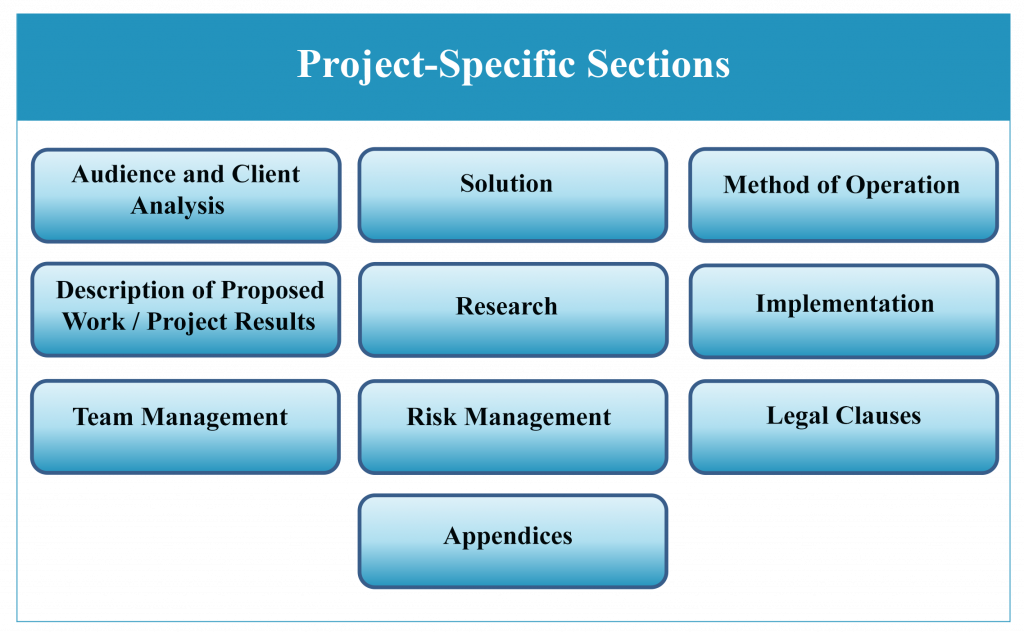
Audience/Client Analysis
Describe the audience of the final recommendation report (which may be different than the audience for the proposal, especially if the proposal is an internal document [requesting time and permission from someone within the organization] but the final report is an external document [the recommendation can only be put into action by someone outside the author’s organization]). You may need to discuss for whom the report is designed, their titles and jobs, their technical background, and their ability to understand the report.
Solution
If you are writing a known-solution proposal, you may want to include a section which focuses on your solution. To create this section, you will need to do some research on topic and use published source information. This section will not present the solution to your problem. However, it will discuss similar problems and solutions that have been attempted in the past. This research will provide information that may be used to formulate a solution relative to your specific problem.
Methods of Operation
In known-solution proposals, this section will tell how the solution will fit into and be used as a functional part of the day to day operation of the company/business. Detail the date you expect to launch the solution into the operation the company, the place from where the solution will operate, how it will operate, and who will be involved (identify their responsibilities, duties, and any titles, certifications, degrees, etc., needed).
Description of the Proposed Work (Results of the Project)
Many proposals describe the finished product of the proposed project. In a technical writing course, this means describing the written document you propose to write (a.k.a. recommendation report) as well as its audience and purpose; providing an outline, and discussing items such as length, use of graphics, binding, and so forth. In this scenario, there may be other work such as conducting training seminars or providing an ongoing service. At this early stage, you might not know all that it will take to complete your project, but you should at least have an idea of some of the steps required.
Research
Provide research on your topic. Your sources should be current, within the last two (2) or three (3) years if possible. It may be helpful to focus on research journals or newspapers for published articles, published interviews, published speeches, etc. for topics which need then newest statistics and information. You will need at least three or four documents that address a problem similar to the one you have chosen. Although you will not find your exact situation/problem, you will find documents about similar problems. These documents should have similar populations, environments, workforces, etc. For example, if you propose to implement a shuttle bus service from the parking lot to your work place for efficiency, you may find documents from other workplaces, with similar circumstances, which experienced similar problems and solved them by providing shuttle bus services. The research will provide you with information that validates your topic as a problem and your solution, as well as validating your proposed implementation, methods of operation, costs, and benefits as credible.
Implementation
In known-solution proposals, you may describe when, why, and how the solution will be used for the first time. This is similar to the Methods of operation section; however, it focuses on a trial period to see if the solution is feasible as planned. Thus, you will pick a time that does not impact the normal operation of existing programs/patterns of operation/etc. In addition, describe the logics: the location, who will be involved, costs, what is expected to happen, the date and time, the duration, and so on. Explain why you chose this time for implementing the solution. Identify how you will observe and record the progress during this trial.
Team Management
If working in teams, this section addresses four main points: a) When, where, and how frequently will your group meet to discuss the ongoing progress of the project? b) When not meeting in person, what methods and technologies will the group use to communicate with one another? c) How will conflicts between group members be resolved? d) What roles will your group members serve in the group structure? (See chapter 11 for information on team roles and management)
Risk Management
This section lists possible issues that could occur during the implementation of your proposal plan, with means to overcome these issues. Information will include possible roadblocks and what you will do to overcome these setbacks. These can be technical hurdles, research-based issues, scheduling obstacles, budgetary limits, or even problems implementing your solution.
Legal Clauses
Some proposals include legal clauses which outline any legal or contractual agreements made for the project. In the workforce, agreements are often made based on performance, meeting deadlines, and/or quality of work, which can affect payment or incur fees. Additionally, your company may have boilerplate legal clauses to accompany all written documents. These are common in many private industries and governmental departments.
Appendices
Appendices contain any information that may be interesting to the reader, but which are not completely necessary to the proposal content. They may include full summaries and responses, a problem analysis, and any information that is meaningful to the proposal. For example, a list of potential survey or interview questions to be asked, common statistical data on the topic, or other more in-depth information that helped shaped the project. Appendices are generally usually labeled with letters (Appendix A, Appendix B, etc.) and are the last components of the document. (See chapter 11 for more detail on appendices content)
9.6 Proposal Design and Style
Your proposal should be visibly attractive, but also easy to read and follow standard format for the type of document used. The most important part of any proposal is for the reader to easily find the information they need to approve your project.
Most proposals follow a standard block format—one inch margins, single spaced text, skip one space between paragraphs, with no paragraph indentation. You also need headings and subheadings to identify and group areas of content and specific sections. The headings levels should contrast with one another, while remaining consistent throughout the document. You may also have graphics in your report, which should be designed to create a consistent style with the text. Last, even though most of your proposal is formatted in block paragraphs, you still need to consider the major elements of design—contrast, repetition, alignment, and proximity (CRAP). (See chapter 5 for more information on document design)
Proposals are written in a professional, but not bureaucratic, style. Think of this as a plain (non-literary) style, but with some appeal to emotion (pathos). Make sure you use terms that are easily understood by the audience and define terms where necessary. Be as clear and concise as possible.
A professional appearance is a basic requirement. If your document is less than professional, you can count on its prompt dismissal. There should be no errors in spelling or grammar, and all information should be concise, accurate, and clearly referenced when appropriate. Information that pertains to credibility should be easy to find and relevant, including contact information. If the document exists in a hard copy form, it should be printed on a letterhead. If the document is submitted in an electronic form, it should be in a file format that presents your document as you intended. Word processing files may have their formatting changed or adjusted based on factors you cannot control—like screen size—and information can shift out of place, making it difficult to understand. In this case, PDF format may be used to preserve content location and avoid any inadvertent format changes when it is displayed.
9.7 Revision checklist for proposals
As you draft and revise your proposal, check for the following:
- Make preplanning decisions: Identify what kind of proposal you will be writing (internal/external; solicited/unsolicited; known or unknown solution) and identify the audience type, skill level, needs, and interests.
- Use the right format: Often, proposals follow a block format, but check with your instructor or the proposal submission guidelines to insure you are using the format requested. If there are samples provided, use them for visual comparison.
- Check submission guidelines: How should the proposal be submitted? What types of follow-up documents or actions are connected to your proposal if accepted? Who will these document address, and when are they required?
- Draft your proposal: Make decisions about the type of content/sections to include in your proposal to meet the submission requirement, the requirements for the type of proposal, and the most effective way to present your idea to the reader.
- Style and Design: Ensure that the sections of your proposal are in a logical, natural order and that you use sub-headers and bullets (and any other formatting styles) correctly.
- Revise, revise, revise: A less than professional, grammatically-incorrect proposal can be rejected. Ensure you have included all content necessary, and revise and edit to ensure clarity and correct style of the audience.
9.8 Proposal Example (Internal, Solicited, Unknown Solution)
Click here to download a copy of the Sample Proposal above
9.9 The Elevator Pitch
On the job, you may be asked to create smaller, more concise proposals, often limited to a single page or, when spoken, a few minutes. Busy decision-makers may not have time to read a lengthy report, and want your proposal parred down to the key points. These reports must focus on capturing the audience’s attention and delivering the information as concisely as possible. Any extraneous information is a waste of precious time. Clear and concise proposals serve the audience well and limit the range of information to prevent confusion.
One type of brief report you may need to create is the elevator pitch. An elevator pitch is a concise, oral proposal, used to persuade the audience in a short amount of time—often less than one minute. An elevator pitch might be used by a salesperson to convince a local business owner to stock her product, or by a screenwriter trying to convince a movie executive to fund his film.
The elevator pitch usually contains the following information:
- Introduce yourself and provide your qualifications. People want to work with the person, not the idea. Making a good impression is key.
- If you are pitching to a general audience, describe your ideal client. This is not necessary if you are speaking to a single person, but you can let them know why you are pitching the idea to them, specifically.
- Grab the reader’s attention. Include a good story, relevant quotes or epigrams, startling statistics, personal anecdotes, and rhetorical questions that engage the audience’s participation or imagination These grab the reader’s attention, but also, people tend to walk away from a presentation remembering a story more than straight facts. Stories also make the audience more emotionally connected to the speaker.
- Summarize and describe your idea in a single sentence. Sometimes this summary might include a memorable slogan or motto.
- Include three compelling reasons why the audience might be interested. Remember to think about your audience’s needs, wants, and values.
- Mention how your idea is special or unique. Why is your idea superior, more necessary, or needed now, as opposed to other ideas? You can also include benefits of the idea once implemented.
- End with a memorable statement about yourself. Like in Step 1, creating a personal link so the audience will want to work with you in the future. If possible, leave them with contact information, such as a business card or a handout of your pitch’s highlights.
(See chapter 12 for tips on public speaking to help you pitch your idea effectively)
Attribution
Material in this chapter was adapted from the works listed below. The material was edited for tone, content, and localization.
Technical Writing, by Allison Gross, Annamarie Hamlin, Billy Merck, Chris Rubio, Jodi Naas, Megan Savage and Michele DiSilva, licensed CC-BY-NC-SA.
ENGL 145 Technical and Report Writing, by the Bay College Online Learning Department, licensed CC-BY.

